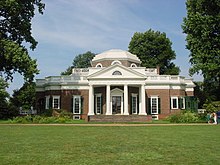Monticello (Virginia)
Monticello ( Italian for little mountain ), in Charlottesville in the US state of Virginia location was the estate of the third US president and author of the American Declaration of Independence Thomas Jefferson , for which the Palladian style built residential building he himself had created the plans. Together with the University of Virginia , also designed by Jefferson, UNESCO declared Monticello a World Heritage Site in 1987 .
investment
The mansion of Monticello was built on his plantation by Jefferson from 1768 according to his own designs in the classical style, inspired by Andrea Palladio . Most of the construction work was completed in 1809, but Jefferson kept building Monticello throughout his life. The house is one of the most important buildings from the early days of the United States . The Jeffersonian facility has largely been preserved, including its library and science collections. In addition to the house, the farm buildings have also been preserved or reconstructed.
Archaeological investigations of the former plantation area and the former homes of the slaves will continue into the 21st century. Among other things, the finds provide information about the life of slaves in the 18th and 19th centuries, about which their white contemporaries have handed down very little. The finds showed that the slaves on the plantation were initially housed in communal houses, but in the 19th century lived in family accommodations.
In December 1960, Monticello was granted National Historic Landmark status. In October 1966, the property was listed as a building on the National Register of Historic Places . Monticello is now owned by the non-profit Thomas Jefferson Foundation, which makes it available to the public. It is a much visited memorial.
Illustration on American currency
Monticello has been depicted on the reverse of the American 5-cent piece , the so-called nickel , since 1938, with an interruption from 2004 to 2005 . The obverse traditionally shows the portrait of Jefferson.
A change in the motif planned by the American mint in 2003 led to political resistance under the leadership of the US Congressman from Virginia, Eric Cantor , who has been a member of the electoral district in which Monticello is located since 2001. The protest finally had the effect that only in 2004 and 2005 coins with a total of four new motifs were minted. Since January 2006, Monticello has been shown on the back in the representation that has hardly changed since 1938 (although the front portrait was redesigned by Jefferson).
Monticello was also from 1928 to 1966 on the back of the 2 dollars - Note mapped. The motif is also used on postage stamps .
Web links
- http://www.monticello.org/
- Broadcast about Montecello from the ARD series "Schätz der Welt" ( Memento from March 25, 2002 in the Internet Archive )
- Entry on the UNESCO World Heritage Center website ( English and French ).
Individual evidence
- ↑ Listing of National Historic Landmarks by State: Virginia. National Park Service , accessed March 6, 2020.
- ^ Monticello on the National Register of Historic Places , accessed March 6, 2020.
Coordinates: 38 ° 0 ′ 32.4 " N , 78 ° 27 ′ 10.8" W.



